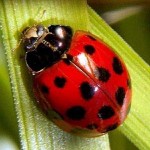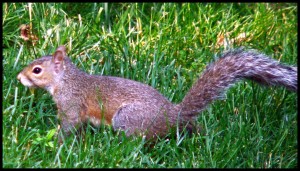READY TO GET STARTED?
REQUEST A FREE ESTIMATE
Fill out the form below or call (888) 466-7849 for a free, no-obligation estimate.
 Ladybugs Seek Warmth in Homes
Ladybugs Seek Warmth in HomesLadybugs are beneficial insects but when they overwinter in your home they become a nuisance pest. They spend the warmer months of spring and summer growing their populations and like other overwintering pests, they seek warmth from the cold temperatures in fall and winter. Many seek shelter under rocks, leaves, or other items found in nature, then you have those that find shelter in homes and buildings.
Although typically harmless, ladybugs can aggravate asthma and cause allergic reactions in people. They can also emit a foul smelling, yellowish fluid that can stain surfaces.
Keeping ladybugs out of your home starts with the usual preventative pest management steps that we typically cover in our blogs: screen all windows, keep doors closed, door sweeps on exterior doors, and seal all cracks and crevices around the exterior of the home (windows, doors, pipes, etc).
If ladybugs have already found their way into your home, use a vacuum cleaner to clean them up. Empty the vacuum bag into a trash bag and make sure it is tightly closed. Discard of the trash bag in a sealed outside container. If you have a ladybug infestation, call a professional pest control company to evaluate, assess, and treat the problem. Call Northwest Exterminating for more on ladybug pest control.
UGA recently released an article that gave helpful tips on how you can help your home to be less of a target to termites. We all know that termites cause millions of dollars worth of damage each year. Once you have a termite infestation, not only do you have to repair the damage but you must call on the help of a professional to get rid of them. These simple steps are a great way to stay proactive so that termites don’t become an issue.
Tips such as keeping wood products away from the perimeter of your home, keeping water away from the foundation, sealing cracks and crevices in the structure, and working with your termite professional to prevent termites feeding on your home.
To read the full article with helpful tips from UGA entomologist, Brian Forschler, CLICK HERE.
For termite protection on your property, call Northwest!
We’re all looking for ways to save money. We’re cutting back on unnecessary items, thinking twice before we spend our money, and looking for ways to save on necessities. One way to save is to install TAP Insulation in your attic.
Tap Insulation saves in two ways: saving on your energy bills and energy savings (along with many other benefits). When your attic has the right r-value, resistance to heat, then your HVAC system runs more efficiently. Less work for your HVAC means less money each month on the bill. Our highly trained professional will evaluate your current r-value and bring your insulation to the Department of Energy recommended r-value of 49, with a minimum of 30.
It’s typical to see a 20-38% savings on your energy bills after you’ve had TAP Insulation installed. This will benefit your home in both the cold winter months and the warm summer months because it keeps your home at a consistent temperature throughout the season which gives your HVAC system a break. Lastly, TAP Insulation is a GREEN solution for your home. It’s another great way to save green while going green!
Other benefits of TAP Insulation:
The German cockroach is the most common species of cockroach and can be found all around the world. They are most often found in kitchens and bathrooms due to their preference for warm, humid places that are near food and water sources. But you won’t always see them out in the open because they like to live in the cracks and crevices around homes and commercial buildings. In fact, they spend 75% of their time in the cracks and crevices.
Environment of German cockroaches:
Not only are German cockroaches a nuisance pest but they are also a health risk. Studies have shown that German cockroaches have been linked to illness and allergic reaction in humans, especially children. They can spread at least 33 kinds of bacteria, six parasitic worms, and at least seven other kinds of human pathogens. They pick up germs while crawling around and transfer them as they crawl on our food and surfaces. They spread allergens as they crawl, and deposit droppings, secretions, cast skins, and dead bodies.
Health threats of German cockroaches:
Contact a professional pest control company if you think German cockroaches have taken up residence in your home. Trained personnel know where to look for harborage sites and what products to apply to achieve fast and effective results. It is much easier to eliminate a German cockroach problem when it is newly established and small, rather than when the population has time to build.
 Do you have trees near your home? If so, then you have a threat of squirrels getting into your attic. They may look cute with their furry little bodies but don’t let them fool you, they can cause some major damage. When they live in your home they damage insulation, electrical cables (potential fire hazard) and can be unsanitary by leaving urine and droppings throughout your attic.
Do you have trees near your home? If so, then you have a threat of squirrels getting into your attic. They may look cute with their furry little bodies but don’t let them fool you, they can cause some major damage. When they live in your home they damage insulation, electrical cables (potential fire hazard) and can be unsanitary by leaving urine and droppings throughout your attic.
One of the first clues that people experience is the sound of scratching, clawing, gnawing, or scurrying noises. If you think that you may have squirrels in your attic, call a professional. Squirrel removal is not recommended for amateurs.
Things that you can do to prevent squirrels from getting into your attic:
All of these things can help but squirrels are excellent climbers and will sometimes find alternate ways to get into your home to feed and give birth. The best solution is to call Northwest Exterminating to remove the squirrels in your attic.